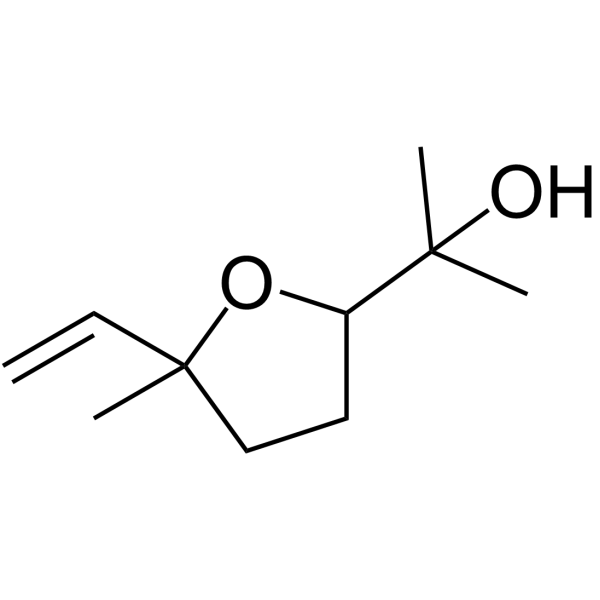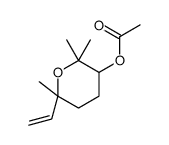14049-11-7
| Name | 2,2,6-trimethyl-6-vinyltetrahydro-2h-pyran-3-ol |
|---|---|
| Synonyms |
6-ethenyl-2,2,6-trimethyl-3-hydroxytetrahydropyran
2,2,6-Trimethyl-6-vinyltetrahydropyran-3-ol 2H-Pyran-3-ol,tetrahydro-2,2,6-trimethyl-6-vinyl cis-linalool oxide Epoxylinalol 2,2,6-Trimethyl-6-vinyltetranhydro-2H-pyran-3-ol 3-hydroxy-2,2,6-trimethyl-6-vinyltetrahydropyran 2,2,6-trimethyl-6-vinyl-tetrahydro-2H-pyran-3-ol tetrahydro-2,2,6-trimethyl-6-vinyl-2H-pyran-3-ol Pyranoid-linalool oxide 2,2,6,6-TETRAMETHYL-4-PIPERIDINOL EINECS 237-889-1 linalool oxide pyranoside 2H-Pyran-3-ol,6-ethenyltetrahydro-2,2,6-trimethyl 2,2,6-trimethyl-6-ethenyltetrahydro-2H-pyran-3-ol |
| Density | 0.988g/cm3 |
|---|---|
| Boiling Point | 224.2ºC at 760mmHg |
| Molecular Formula | C10H18O2 |
| Molecular Weight | 170.24900 |
| Flash Point | 76.5ºC |
| Exact Mass | 170.13100 |
| PSA | 29.46000 |
| LogP | 1.88100 |
|
Section I.Chemical Product and Company Identification Chemical Name2,2,6-Trimethyl-6-vinyltetrahydropyran-3-ol (mixture of isomers) Portland OR 2H-Pyran-3-ol, 6-ethenyltetrahydro-2,2,6-trimethyl- Synonym (CA INDEX NAME); Linalool Oxide Pyranoid;
3-Hydroxy-2,2,6-trimethyl-6-vinyltetrahydropyran Chemical FormulaC10H18O2 CAS Number14049-11-7 Section II.Composition and Information on Ingredients CAS Number Percent (%)TLV/PELToxicology Data Chemical Name 2,2,6-Trimethyl-6-vinyltetrahydropyran-3-ol14049-11-7 Min. 98.0 (GC) Not available.Not available. (mixture of isomers) Section III. Hazards Identification Acute Health EffectsIrritating to eyes and skin on contact. Inhalation causes irritation of the lungs and respiratory system. Inflammation of the eye is characterized by redness, watering, and itching. Skin inflammation is characterized by itching, scaling, reddening, or, occasionally, blistering. Follow safe industrial hygiene practices and always wear proper protective equipment when handling this compound. Chronic Health EffectsCARCINOGENIC EFFECTS : Not available. MUTAGENIC EFFECTS : Not available. TERATOGENIC EFFECTS : Not available. DEVELOPMENTAL TOXICITY: Not available. Repeated or prolonged exposure to this compound is not known to aggravate existing medical conditions. Section IV.First Aid Measures Eye ContactCheck for and remove any contact lenses. In case of contact, immediately flush eyes with plenty of water for at least 15 minutes. Get medical attention. Skin ContactIn case of contact, immediately flush skin with plenty of water. Remove contaminated clothing and shoes. Wash clothing before reuse. Thoroughly clean shoes before reuse. Get medical attention. If the victim is not breathing, perform mouth-to-mouth resuscitation. Loosen tight clothing such as a collar, tie, belt or Inhalation waistband. If breathing is difficult, oxygen can be administered. Seek medical attention if respiration problems do not improve. INDUCE VOMITING by sticking finger in throat. Lower the head so that the vomit will not reenter the mouth and throat. Ingestion Loosen tight clothing such as a collar, tie, belt or waistband. If the victim is not breathing, perform mouth-to-mouth resuscitation. Examine the lips and mouth to ascertain whether the tissues are damaged, a possible indication that the toxic material was ingested; the absence of such signs, however, is not conclusive. Section V.Fire and Explosion Data Not available. May be combustible at high temperature.Auto-Ignition Flammability Flash PointsFlammable LimitsNot available. Not available. Combustion ProductsThese products are toxic carbon oxides (CO, CO2). Fire Hazards Not available. Risks of explosion of the product in presence of mechanical impact: Not available. Explosion Hazards Risks of explosion of the product in presence of static discharge: Not available. Fire Fighting MediaSMALL FIRE: Use DRY chemical powder. and InstructionsLARGE FIRE: Use water spray, fog or foam. DO NOT use water jet. Consult with local fire authorities before attempting large scale fire-fighting operations. Continued on Next Page 2,2,6-Trimethyl-6-vinyltetrahydropyran-3-ol (mixture of isomers) Section VI.Accidental Release Measures Spill CleanupIrritating material. Absorb with an inert material and put the spilled material in an appropriate waste disposal. Finish cleaning the spill by rinsing Instructions any contaminated surfaces with copious amounts of water. Consult federal, state, and/or local authorities for assistance on disposal. Section VII. Handling and Storage Handling and StorageIRRITANT. Keep away from heat. Mechanical exhaust required. When not in use, tightly seal the container and store in a dry, cool place. Avoid excessive heat and light. Do not breathe gas/fumes/ vapor/spray. Information Always store away from incompatible compounds such as oxidizing agents. Section VIII. Exposure Controls/Personal Protection Provide exhaust ventilation or other engineering controls to keep the airborne concentrations of vapors below their respective Engineering Controls threshold limit value. Ensure that eyewash station and safety shower is proximal to the work-station location. Splash goggles. Lab coat. Vapor respirator. Boots. Gloves. Suggested protective clothing might not be sufficient; consult a Personal Protection specialist BEFORE handling this product. Be sure to use a MSHA/NIOSH approved respirator or equivalent. Exposure LimitsNot available. Section IX. Physical and Chemical Properties Liquid. (Clear, colorless ~ light yellow.)Solubility Physical state @ 20°CNot available. Not available. Specific Gravity 170.25 Molecular WeightPartition CoefficientNot available. Boiling Point98°C (208.4°F) @ 10 mmHgVapor PressureNot available. Not available.Not available. Melting PointVapor Density Not available.VolatilityNot available. Refractive Index Not available. Critical TemperatureNot available.Odor ViscosityNot available.TasteNot available. Section X.Stability and Reactivity Data Stability This material is stable if stored under proper conditions. (See Section VII for instructions) Conditions of InstabilityAvoid excessive heat and light. Incompatibilities Reactive with oxidizing agents. Section XI. Toxicological Information Not available. RTECS Number Routes of ExposureEye Contact. Ingestion. Inhalation. Not available. Toxicity Data Chronic Toxic EffectsCARCINOGENIC EFFECTS : Not available. MUTAGENIC EFFECTS : Not available. TERATOGENIC EFFECTS : Not available. DEVELOPMENTAL TOXICITY: Not available. Repeated or prolonged exposure to this compound is not known to aggravate existing medical conditions. Acute Toxic EffectsIrritating to eyes and skin on contact. Inhalation causes irritation of the lungs and respiratory system. Inflammation of the eye is characterized by redness, watering, and itching. Skin inflammation is characterized by itching, scaling, reddening, or, occasionally, blistering. Follow safe industrial hygiene practices and always wear proper protective equipment when handling this compound. Section XII.Ecological Information Not available. Ecotoxicity Environmental FateNot available. Continued on Next Page 2,2,6-Trimethyl-6-vinyltetrahydropyran-3-ol (mixture of isomers) Section XIII.Disposal Considerations Recycle to process, if possible. Consult your local regional authorities. You may be able to dissolve or mix material with a Waste Disposal combustible solvent and burn in a chemical incinerator equipped with an afterburner and scrubber system. Observe all federal, state and local regulations when disposing of the substance. Section XIV. Transport Information DOT ClassificationNot a DOT controlled material (United States). PIN NumberNot applicable. Proper Shipping NameNot applicable. Packing Group (PG)Not applicable. DOT Pictograms Section XV. Other Regulatory Information and Pictograms TSCA Chemical InventoryThis compound is ON the EPA Toxic Substances Control Act (TSCA) inventory list. (EPA) WHMIS ClassificationOn DSL. (Canada) EINECS Number (EEC) 237-889-1 EEC Risk StatementsR36/37/38- Irritating to eyes, respiratory system and skin. SECTION 16 - ADDITIONAL INFORMATION N/A |
| Hazard Codes | Xn |
|---|---|
| HS Code | 2932999099 |
| Precursor 2 | |
|---|---|
| DownStream 1 | |
| HS Code | 2932999099 |
|---|---|
| Summary | 2932999099. other heterocyclic compounds with oxygen hetero-atom(s) only. VAT:17.0%. Tax rebate rate:13.0%. . MFN tariff:6.5%. General tariff:20.0% |








